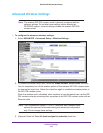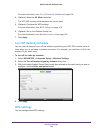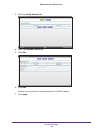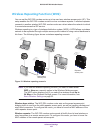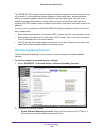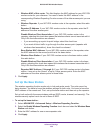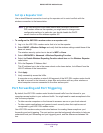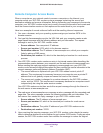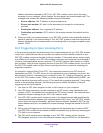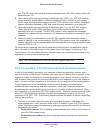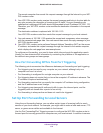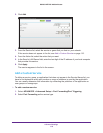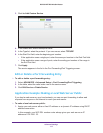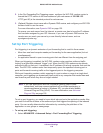
Advanced Settings
111
D6200 WiFi DSL Modem Router
Remote Computer Access Basics
When a computer on your network needs to access a computer on the Internet, your
computer sends your WiFi DSL modem router a message containing the source and
destination address and process information. Before forwarding your message to the remote
computer, your WiFi DSL modem router has to modify the source information and create and
track the communication session so that replies can be routed back to your computer.
Here is an example of normal outbound traffic and the resulting inbound responses:
1. You open a browser, and your operating system assigns port number 5678 to this
browser session.
2. You type http://www.example.com into the URL field, and your computer creates a web
page request message with the following address and port information. The request
message is sent to your WiFi DSL modem router.
• Source address. Your computer’s IP address.
• Source port number. 5678, which is the browser session.
• Destination address. The IP address of www.example.com, which your computer
finds by asking a DNS server.
• Destination port number. 80, which is the standard port number for a web server
process.
3. Your WiFi DSL modem router creates an entry in its internal session table describing this
communication session between your computer and the web server at www.example.com.
Before sending the web page request message to www.example.com, your WiFi DSL
modem router stores the original information and then modifies the source information in the
request message, performing Network Address Translation (NAT):
• The source address is replaced with your WiFi DSL modem router’s public IP
address. This requirement is necessary because your computer uses a private IP
address that is not globally unique and cannot be used on the Internet.
• The source port number is changed to a number chosen by the WiFi DSL modem
router, such as 33333. This requirement is necessary because two computers could
independently be using the same session number.
Your WiFi DSL modem router then sends this request message through the Internet to
the web server at www.example.com.
4. The web server at www.example.com composes a return message with the requested web
page data. The return message contains the following address and port information. The
web server then sends this reply message to your WiFi DSL modem router.
• Source address. The IP address of www.example.com.
• Source port number. 80, which is the standard port number for a web server
process.
• Destination address. The public IP address of your WiFi DSL modem router.
• Destination port number. 33333.
5. Upon receiving the incoming message, your WiFi DSL modem router checks its session
table to determine whether an active session for port number 33333 exists. Finding an active
session, the WiFi DSL modem router then modifies the message to restore the original



